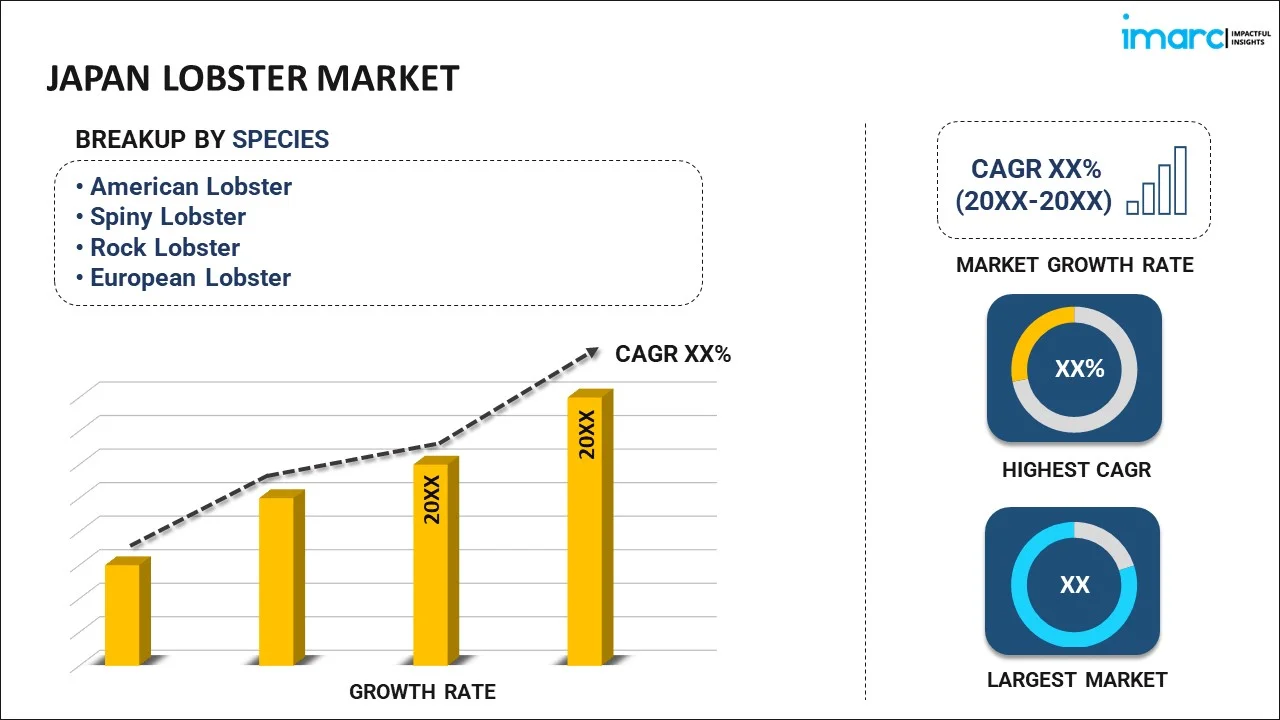
Japan Lobster Market Report by Species (American Lobster, Spiny Lobster, Rock Lobster, European Lobster), Weight (0.5 – 0.75 lbs, 0.76 – 3.0 lbs, Over 3 lbs), Product Type (Whole Lobster, Lobster Tail, Lobster Meat, Lobster Claw), Distribution Channel (Food Service, Retail), and Region 2025-2033
Market Overview:
The Japan lobster market size reached 7,640 Tons in 2024. Looking forward, IMARC Group expects the market to reach 12,300 Tons by 2033, exhibiting a growth rate (CAGR) of 5.5% during 2025-2033.
|
Report Attribute
|
Key Statistics
|
|---|---|
|
Base Year
|
2024
|
|
Forecast Years
|
2025-2033
|
|
Historical Years
|
2019-2024
|
|
Market Size in 2024
|
7,640 Tons |
|
Market Forecast in 2033
|
12,300 Tons |
| Market Growth Rate 2025-2033 | 5.5% |
Lobster is an invertebrate with a rigid, segmented exoskeleton and modified claws. It belongs to the phylum Arthropoda family, comprising a wide variety of essential nutrients. These include copper, zinc, selenium, phosphorous, magnesium, vitamin E and B12, and omega-3 fatty acid. Lobsters contain less fat as compared to chicken and are considered to be rich and decadent food. Consequently, their intake has increased among health-conscious consumers in Japan.
Japan holds a significant share in the global lobster market. The market is primarily driven by numerous health and nutritional benefits offered by lobsters. Due to the presence of proteins, lobsters are widely consumed to repair damaged tissues, strengthen bones, and boost energy. They also act as an antioxidant and help in improving thyroid function. Besides this, frozen lobster is exported from Canada into Japan due to its easy availability and inadequate domestic production in Japan. Furthermore, market players are adding several value-added products to their product lines, which are gaining popularity in Japan, thereby enhancing the existing consumer base across the country.
Key Market Segmentation:
IMARC Group provides an analysis of the key trends in each sub-segment of the Japan lobster market report, along with forecasts at the country and regional level from 2025-2033. Our report has categorized the market based on species, weight, product type and distribution channel.
Breakup by Species:

- American Lobster
- Spiny Lobster
- Rock Lobster
- European Lobster
Breakup by Weight:
- 0.5 – 0.75 lbs
- 0.76 – 3.0 lbs
- Over 3 lbs
Breakup by Product Type:
- Whole Lobster
- Lobster Tail
- Lobster Meat
- Lobster Claw
Breakup by Distribution Channel:
- Food Service
- Retail
Breakup by Region:

- Kanto Region
- Kinki Region
- Central/ Chubu Region
- Kyushu-Okinawa Region
- Tohoku Region
- Chugoku Region
- Hokkaido Region
- Shikoku Region
Competitive Landscape:
The competitive landscape of the industry has also been examined along with the profiles of the key players.
Report Coverage:
| Report Features | Details |
|---|---|
| Base Year of the Analysis | 2024 |
| Historical Period | 2019-2024 |
| Forecast Period | 2025-2033 |
| Units | '000 Tons |
| Segment Coverage | Species, Weight, Product Type, Distribution Channel, Region |
| Region Covered | Kanto Region, Kinki Region, Central/ Chubu Region, Kyushu-Okinawa Region, Tohoku Region, Chugoku Region, Hokkaido Region, Shikoku Region |
| Customization Scope | 10% Free Customization |
| Post-Sale Analyst Support | 10-12 Weeks |
| Delivery Format | PDF and Excel through Email (We can also provide the editable version of the report in PPT/Word format on special request) |
Key Questions Answered in This Report:
- How has the Japan lobster market performed so far and how will it perform in the coming years?
- What has been the impact of COVID-19 on the Japan lobster market?
- What are the key regional markets?
- What is the breakup of the market based on the species?
- What is the breakup of the market based on the weight?
- What is the breakup of the market based on the product type?
- What is the breakup of the market based on the distribution channel?
- What are the various stages in the value chain of the industry?
- What are the key driving factors and challenges in the industry?
- What is the structure of the Japan lobster market and who are the key players?
- What is the degree of competition in the industry?
Need more help?
- Speak to our experienced analysts for insights on the current market scenarios.
- Include additional segments and countries to customize the report as per your requirement.
- Gain an unparalleled competitive advantage in your domain by understanding how to utilize the report and positively impacting your operations and revenue.
- For further assistance, please connect with our analysts.
 Request Customization
Request Customization
 Speak to an Analyst
Speak to an Analyst
 Request Brochure
Request Brochure
 Inquire Before Buying
Inquire Before Buying




.webp)




.webp)












